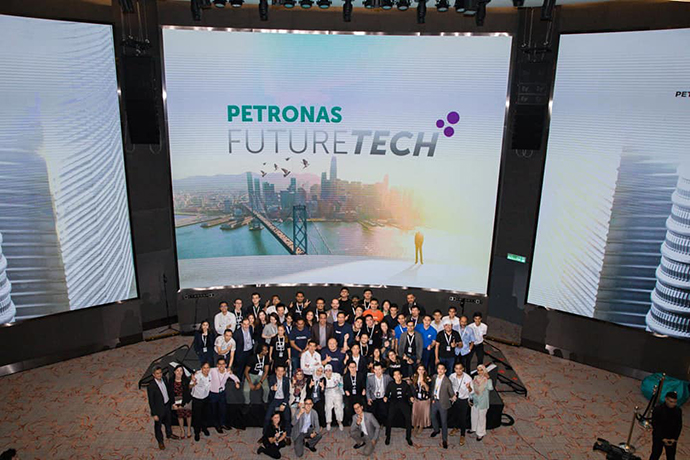
Arni Laily, Head of PETRONAS Ventures
Market trends may come and go, but one industry that remains relevant and is gaining ever-increasing importance is the energy sector. While some industries go through occasional dips, especially with the global health crisis upon us, the important role of energy has only been magnified by the unpredictable global events that shape how we live.
The energy sector now faces the crucial responsibility of spearheading innovations in many key areas and emboldening startups and companies from other relevant verticals to initiate growth and innovation within their own industries.
PETRONAS, a global energy and solutions partner with a presence in over 50 countries, recently launched the second edition of its technology accelerator programme, PETRONAS FutureTech 2.0, as part of the company’s initiative to move towards a culture of open innovation within the startup landscape.
What is FutureTech 2.0?
FutureTech 2.0, led by PETRONAS via its corporate venture capital arm PETRONAS Ventures in collaboration with government-linked companies (GLCs) Telekom Malaysia Berhad (TM) and Sime Darby Plantation Berhad (SDP) as well as global venture capital firm 500 Global, complements PETRONAS’ commitment in delivering cleaner energy solutions to achieve its net-zero carbon emissions target by 2050.
The accelerator programme, which is held from 30 August 2021 to 19 November 2021 also supports Malaysia’s aspiration to spur growth among local startups and venture capital ecosystem builders by working closely with the National Technology Innovation Sandbox programme — an initiative sparked by the Ministry of Science, Technology and Innovation.
FutureTech 2.0 revolves around three key areas: Facilities of the Future, Future of Energy, and New Chemicals/Advanced Materials. These particular focus areas are aligned with PETRONAS’ technology agenda.
Also read: Japan’s Aichi prefecture all set to build the city of the future by co-creating with startups
Serving PETRONAS’ business needs as it explores new growth opportunities, the 12-week accelerator programme empowers both participating startups and PETRONAS’ business units to find best-fit use cases to address current pain points, catalyse growth and future-proofing.
FutureTech 2.0 offers its cohort a blend of global and local learning experiences, which includes masterclasses from 500 Global, mentors and local industry experts. The bigger value proposition of the programme is that the participants are able to have access to the expertise and networks of PETRONAS and its corporate partners, where mentors share relevant pain points within specific business segments.
Other programme benefits include fire-side chats with successful founders and global/local ecosystem builders, access to 500 Globals’ programme perks and networks, potential investors, GLCs, and partners.
FutureTech’s non-traditional approach
Apart from the intrinsically non-traditional framework of the accelerator programme which offers a unique two-way engagement between participating startups and corporate partners, FutureTech 2.0’s unique approach to present industry problems also manifests in PETRONAS Ventures’ drive to disrupt existing markets.
Head of PETRONAS Ventures, Arni Laily Anwarrudin explained, “We need to go beyond just oil and gas, which means we have to move towards a broader energy sector. So partnering with startups is the way to go because it provides PETRONAS with the insider intelligence and insights needed to accelerate in areas we may not currently see [from the perspective of] a traditional oil and gas company.”
Through this framework, all participating parties gain value from each other’s wealth of knowledge and experience, harnessing key contributors that help accelerate each other’s journey towards a healthy market strategy.
Also read: IES-INCA partners with e27 to support deep tech innovators
The partnership, therefore, changes the corporate innovation landscape and trend by encouraging the innovation culture using agile approaches. By leveraging on the non-traditional thinking embedded in startup culture and the industry know-how of corporates, both stakeholders stand a better chance at fostering smarter, stronger, and more resilient forms of innovation.
Moreover, PETRONAS also believes in internalising important processes in approaching how startups operate. Through FutureTech 2.0, participating startups are able to extend their services and commercial offerings with PETRONAS and its corporate partners in ways that are lean and agile while still conforming with corporate governance standards. In a nutshell, this helps fast-track their ability to commercialise within PETRONAS and the partners’ ecosystem.
Focusing on energy, industry, and digital innovation as key areas

Following the success of the first FutureTech programme in 2019, PETRONAS recognised bigger prospects towards nation-building and saw collaborating with major corporations such as SDP and TM as the way to further nurture the ecosystem.
FutureTech 2.0 also seeks to create socio-economic impact for the community through various channels, including education and skill investment. The programme also aims to foster tech-driven innovations that support the United Nations’ Sustainable Development Goals.
Arni said, “Technology as a differentiator is the central thrust of our technology agenda. We are steadfast in advancing selective technologies whilst accelerating pace of delivery via critical and strategic collaborations that add to our resource and reserve.” On top of improving efficiencies and operational excellence, she added, PETRONAS strives to differentiate their offerings to gain a competitive and resilient advantage in the energy market.
Diversity in participating startups

FutureTech 2.0 prides itself on prioritising startups with breakthrough technology or innovative business solutions — “disruptors” that can exhibit exemplary talent in improving how we observe, strategise, and execute deployment in PETRONAS as well as its corporate partners, TM and SDP. As such, this year’s participants encompass a diverse slew of startups coming from a wide array of verticals.
Also read: Blue skies for Malaysia’s drone industry with Aerodyne
The FutureTech 2.0 cohort of 20 promising startups include Aerodyne, a drone-based enterprise solutions provider; Poseidon, a digital monitoring technology to assess onshore/offshore structural integrity in real-time; and Boom Grow, a 5G-connected vertical farm. They are only some of the most innovative tech-driven startups in Malaysia today.
Selected startups will receive continued support from PETRONAS, TM, and SDP after the programme, should future partnerships be deemed necessary.
PETRONAS Ventures’ reputable global stamp
PETRONAS’ commitment to raising the bar doesn’t end at inculcating global standards to local startups. Through PIVA Capital in San Francisco, PETRONAS Ventures has a strong partner to tap into the Silicon Valley ecosystem which boasts the largest pool of quality resources in terms of capital, talent, investors, mentors, and scaling experience. The company has also successfully pursued networking opportunities with the symbiotic ecosystem comprising universities, startups, large tech companies, and venture capitalists among others.
With its Environmental, Social, and Governance (ESG) framework, PETRONAS is able to create value upon investing in nine companies to date and help to redefine trillion-dollar markets such as agriculture, manufacturing, chemicals, transportation, and energy.
Startups chosen to participate in FutureTech 2.0 become part of the same legacy of excellence that the company has built. As PETRONAS moves toward revolutionising the energy sector not only in Malaysia, but also across the world, the FutureTech 2.0 cohort of startups and their innovations become instrumental in shaping the future.
– –
This article is produced by the e27 team, sponsored by PETRONAS Ventures
We can share your story at e27, too. Engage the Southeast Asian tech ecosystem by bringing your story to the world. Visit us at e27.co/advertise to get started.
The post PETRONAS FutureTech 2.0 to catalyse tech startup innovation in the energy sector appeared first on e27.


TRT vs. Steroids: Legal Status, Differences, and Side
Effects
TRT, or Testosterone Replacement Therapy, and anabolic steroids are both performance-enhancing drugs, but they
have distinct differences in their legal status, mechanisms,
and potential side effects.
Legal Status
TRT is often classified as a therapeutic drug when used to treat low testosterone
levels due to medical conditions. In many countries,
it requires a prescription from a healthcare provider. On the other hand, anabolic steroids are typically classified as controlled substances and are illegal to possess or use without a legitimate
medical reason.
Differences
TRT primarily functions by supplementing endogenous testosterone in individuals with
hypogonadism or testosterone deficiency. In contrast, anabolic steroids are designed to mimic the effects of testosterone in muscle building
and fat burning, often leading to significant increases in muscle
mass.
Side Effects
Both TRT and anabolic steroids carry potential side effects, but they vary in nature.
TRT can cause side effects such as acne, hair loss, and increased risk of heart disease.
Anabolic steroid abuse, however, is associated with more severe health risks, including liver damage, cardiovascular
issues, and behavioral problems.
It’s important to consult with a healthcare professional before considering either substance, as improper
use can lead to serious health complications.
**TRT vs Steroids: Understanding the Differences and
Benefits**
In the world of fitness and health, there are various approaches individuals take to achieve their goals.
Two popular methods are Testosterone Replacement Therapy (TRT) and Anabolic Steroids.
While both aim to enhance physical performance and muscle growth, they differ significantly
in their use, side effects, and legal status.
This article delves into the key aspects of TRT vs Steroids to help you make an informed decision.
### Key Takeaways
– **TRT**: Used for hormone replacement, often due to low testosterone levels.
– **Steroids**: Synthetic hormones used primarily for muscle gain in bodybuilding.
– **Legality**: TRT is legal with a prescription; Steroids are illegal without a medical need.
– **Side Effects**: Both have risks but differ in severity and nature.
### What is Testosterone Replacement Therapy (TRT)?
Testosterone Replacement Therapy is a treatment where synthetic testosterone is administered
to individuals with low testosterone levels.
It’s commonly used for conditions like hypogonadism,
where the body doesn’t produce enough testosterone on its own.
TRT helps regulate hormones, improving energy, libido,
and overall health.
### What are Anabolic Steroids?
anabolic steroids are a type Of (S777casino.com) synthetic hormone designed to
mimic testosterone’s muscle-building effects. They are often used in bodybuilding
circles to enhance muscle mass and strength. However, their misuse is illegal without
a proper medical prescription.
### The Differences between TRT vs Steroids
1. **Purpose**: TRT addresses low testosterone by replacing it, while Steroids are used to boost muscle growth beyond natural
levels.
2. **Legality**: TRT is legal when prescribed by a
doctor, whereas Steroids are classified as controlled substances and illegal without a valid prescription for medical use.
3. **Dosage**: TRT doses are typically lower and more regulated, while
Steroid doses vary widely and can be dangerous if misused.
### Side Effects of TRT vs Steroid(s)
– **TRT**: Potential side effects include acne,
hair loss, and mood changes. Long-term risks like cardiovascular issues and infertility require monitoring.
– **Steroids**: Side effects are more severe and can include liver
damage, kidney issues, and psychological disorders. Misuse can lead to dependency.
### Benefits of TRT vs Steroid(s)
– **TRT**: Improves health by addressing low testosterone, enhancing energy, and promoting well-being.
– **Steroids**: Provide significant muscle gains, boosting performance in sports or bodybuilding.
### TRT and Steroids Dosing
TRT doses are usually measured in milligrams per week, tailored to
individual needs under medical supervision. Steroid dosing varies widely, with cycles often ranging from weeks to months, but misuse can lead to
toxic levels.
### TRT for Muscle Mass
While TRT primarily treats medical conditions, some users report muscle gain.
However, it’s not as effective as Steroids and shouldn’t be used
without a prescription to avoid legal issues.
### Legal Alternatives to Anabolic Steroids
Looking for legal ways to boost performance? Consider natural testosterone enhancers
like zinc or vitamin D supplements. These support overall health
without the risks associated with Steroids.
### Is TRT Legal?
Yes, TRT is legal in many countries when prescribed by a healthcare provider.
Its use outside of medical guidance can lead to legal consequences, though.
### Is TRT Safe?
TRT is generally safe when used correctly under supervision. Long-term
health monitoring is crucial to mitigate risks like cardiovascular issues or infertility.
### Conclusion: TRT is Legal, Steroids Ain’t
While both have their uses, TRT operates within legal boundaries and
aims to address medical conditions. Steroids, on the other hand, are
misused for performance enhancement and carry significant legal and health risks.
### Will TRT get me ripped?
TRT can aid in muscle growth but is less potent than Steroids for building
mass. Results may vary based on individual health and dosage.
### How fast do you feel TRT?
Effects of TRT typically begin within days, with improvements
in energy and mood. Muscle changes may take longer, depending on the underlying cause of
low testosterone.
### What happens after the first TRT injection?
Injections are usually followed by a period for the body to absorb the hormone.
Effects become apparent over weeks, not immediately.
### Is TRT healthy long term?
Long-term use requires medical supervision and regular monitoring to prevent
complications. Benefits must outweigh the risks in the long run.
### Comments and Questions?
Have questions or feedback about TRT vs Steroids? Share your thoughts below!
### Best Testosterone Enhancers for Men over 50
Looking for natural ways to boost testosterone? Explore our
top picks for men over 50, designed to support overall health and vitality.
### Contributors
Daniel Louwrens BSc PT Writer
### Learn More On This Subject…
– Best Testosterone Enhancers for Men over 50
– Worst Foods That Will Kill Your Testosterone
– Best HRT for Women: The Ultimate Guide
– How to get Insurance to Cover TRT
– How To Lower SHBG?
– Anti-Aging, Peptide, and Health Science Delivered to Your Inbox
—
This article provides a comprehensive overview of TRT vs Steroids, helping you make informed decisions
about health and performance enhancement.
Always consult with a healthcare professional before starting any treatment.
70918248
References:
non anabolic steroids (https://www.scdmtj.com/home.php?mod=space&uid=4692643)